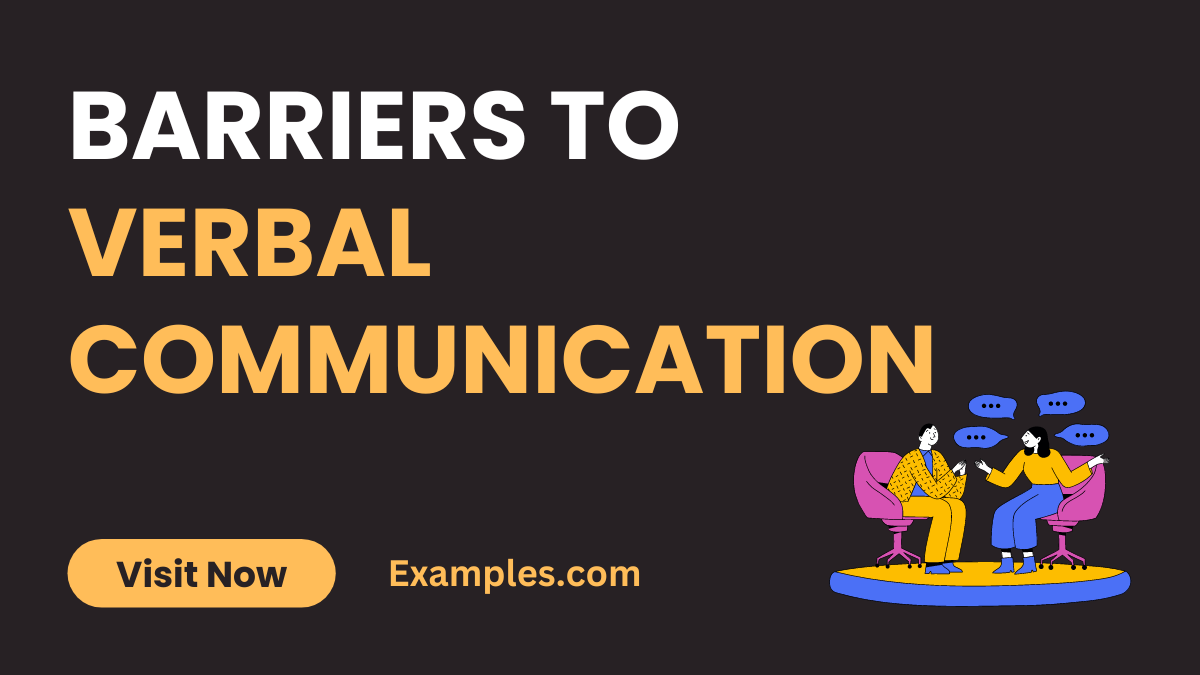14+ Barriers to Verbal Communication Examples
Embark on a journey to decipher the complexities of verbal communication barriers. This comprehensive guide delves into real-world examples, shedding light on challenges faced in diverse settings. Explore practical strategies, tips, and insights to overcome these barriers, fostering effective communication and mutual understanding amidst the rich tapestry of spoken interactions. In this exploration of verbal dynamics, discover how embracing clarity and adapting communication styles enhances global connections and enriches interpersonal interactions.
What are the Barriers to Verbal Communication

Barriers to verbal communication refer to obstacles that impede the smooth exchange of information through spoken words. These hurdles can stem from various sources such as language differences, communication styles, or external factors. Recognizing and addressing these barriers is crucial for effective oral interactions, ensuring that messages are conveyed accurately and understood in diverse contexts. Overcoming these challenges involves cultivating clear communication skills and adapting strategies to bridge gaps, promoting successful verbal exchanges.
15 Barriers To Verbal Communication Examples
Delve into the complexities of verbal communication barriers, hindering seamless exchanges. Unravel practical solutions for fostering clarity and effective spoken interactions in diverse environments.

- Language Differences: Bridging language gaps requires using simple language and providing translations for better understanding.
- Communication Styles Clash: Adapting to diverse communication styles ensures messages resonate across varied preferences.
- Selective Listening: Overcome selective listening by emphasizing active engagement and encouraging attentive responses.
- Noise and Distractions: Mitigate environmental noise by choosing quiet spaces for conversations, ensuring focused communication.
- Lack of Clarity: Ensure clarity by avoiding jargon and confirming understanding through feedback in conversations.
- Cultural Misunderstandings: Navigating cultural nuances involves learning and respecting diverse communication norms.
- Emotional Barriers: Foster emotional intelligence to navigate and address sensitive topics with empathy.
- Physical Barriers: Overcome physical barriers with effective use of technology, enabling seamless communication.
- Lack of Feedback: Promote open feedback to ensure a mutual understanding of messages conveyed.
- Inappropriate Tone: Adjusting tone based on context prevents misunderstandings and conveys the intended message.
- Power Dynamics: Addressing power imbalances fosters a more inclusive and open communication environment.
- Nonverbal Cues Misinterpretation: Understanding nonverbal cues prevents misinterpretations and ensures accurate comprehension.
- Assumptions and Stereotypes: Avoiding assumptions and stereotypes promotes unbiased and clear communication.
- Inattentiveness: Enhance attentiveness through active listening, maintaining eye contact, and reducing distractions.
- Mismatched Expectations: Aligning expectations through clear communication prevents misunderstandings and conflicts.
Barriers to Verbal Communication at Home
Unlock insights into challenges hindering smooth verbal exchanges within familial settings. Overcome obstacles through effective communication strategies, fostering understanding and harmony in the home environment.
- Selective Listening in Family Discussions: Encourage active listening during family conversations by establishing respectful turn-taking practices.
- Noise Interruptions in Household Chats: Designate quiet times for family discussions, minimizing interruptions for clearer verbal communication.
- Generation Gap Dialogue Challenges: Bridge communication gaps between generations with patience, active listening, and shared activities.
- Emotional Barriers in Parent-Child Talks: Foster open dialogue with children, creating a safe space for emotional expression and understanding.
- Inattentiveness During Family Meetings: Boost attentiveness by setting meeting agendas and encouraging active participation among family members.
Barriers to Verbal Communication at Work
Explore impediments to effective verbal communication in the workplace and employ strategies to cultivate a more cohesive and communicative professional environment.
- Jargon Overuse in Team Meetings: Simplify language in team discussions to ensure all members comprehend messages without feeling excluded.
- Leadership-Staff Communication Gap: Bridge the gap by implementing regular communication channels to keep employees informed and engaged.
- Lack of Clarity in Project Briefings: Enhance clarity by providing detailed project briefs and encouraging team members to seek clarification.
- Inappropriate Humour in Office Conversations: Promote a respectful workplace by avoiding offensive humour to prevent discomfort among colleagues.
- Remote Work Communication Challenges: Leverage digital tools effectively to maintain seamless communication among remote team members.
What are the Barriers to verbal communication and How to Overcome
Navigating the landscape of verbal communication challenges is essential for fostering effective dialogue. Explore the diverse barriers that impede clear communication and discover practical strategies to overcome these hurdles in various contexts.
- Introduction to Verbal Communication Barriers
- Define the significance of verbal communication in interpersonal and professional realms.
- Emphasize the role of clear verbal exchanges in building relationships and facilitating understanding.
- Common Barriers to Verbal Communication
- Discuss prevalent obstacles such as language differences, environmental factors, and emotional barriers.
- Illuminate how these barriers manifest in diverse settings, impacting communication dynamics.
- Impact of Verbal Communication Barriers
- Explore the repercussions of ineffective communication on relationships, teamwork, and organizational dynamics.
- Highlight the potential for misunderstandings, conflicts, and decreased productivity.
- Cultural and Diversity Challenges
- Investigate how cultural nuances and diverse communication styles contribute to barriers.
- Provide insights into navigating multicultural settings to enhance cross-cultural communication.
- Emotional and Psychological Hurdles
- Examine emotional intelligence in the context of communication, addressing issues like defensiveness and insecurity.
- Offer strategies for fostering emotional resilience and creating a supportive communication environment.
- Environmental Factors Impacting Communication
- Analyze the role of noise, distractions, and physical barriers in impeding clear verbal exchanges.
- Propose solutions for mitigating environmental challenges to enhance communication effectiveness.
- Strategies to Overcome Verbal Communication Barriers
- Introduce proactive measures for enhancing communication skills and fostering a conducive environment.
- Explore the importance of active listening, clarity, and adaptability in overcoming barriers.
- Building Inclusive Communication Practices
- Advocate for inclusive communication practices that accommodate diverse styles and preferences.
- Provide guidelines for creating an environment where all voices are heard and valued.
In conclusion, understanding and addressing barriers to verbal communication is pivotal for fostering meaningful connections. By recognizing challenges, implementing effective strategies, and promoting inclusivity, individuals and organizations can navigate diverse contexts with clarity. This complete guide provides valuable insights and examples, empowering readers to enhance their communication skills and overcome obstacles for more effective interpersonal and professional interactions.



